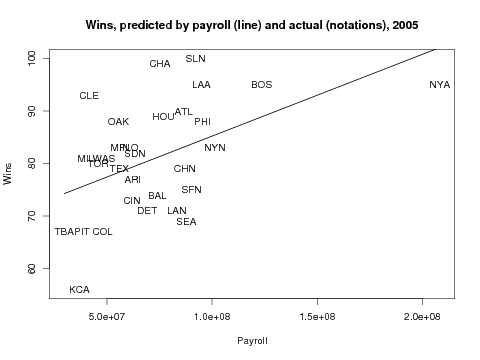A couple days ago, in an article about prospect analysis in baseball (subscription required) Nate Silver produced a cool table showing the year to year correlations of the six major batting events. This morning while I wait for my dough to rise, I decided to replicate this analysis with my new found baseball hack ability.
You can download the R program code for the analysis by clicking on the link.
Here's the result, showing the 2004 to 2005 correlations for rate-adjusted batting statistics for all players with more than 250 at-bats in both seasons:
Hits / PA 0.422 Singles / PA 0.663 Doubles / PA 0.369 Triples / PA 0.501 Home Runs / PA 0.702 Walks / PA 0.718 Strikeouts / PA 0.813 Plate appearances 0.405
What Silver was trying to show by presenting his table (which included all year to year correlations since World War II) is that "there's really no such thing as a doubles hitter."
You can see from looking at the table that there's very little relationship between how many doubles a hitter hit in 2004 and how many they got in 2005. But a home run hitter in one season is likely to hit them at the same rate in the next season. Also note that strikeouts and walks are very highly correlated. So, 2004 and 2005 strikeout leader Adam Dunn is likely to strike out more than 150 times in 2006. Thankfully for Reds fans, he'll probably also hit more than 40 home runs.
The last number is also interesting. There isn't a great correlation between plate appearances between seasons. This is probably a combination of older players breaking down between 2004 and 2005, and younger players stepping in to take their place at the plate.
Yesterday I discovered (and ordered!) a new book from O'Reilly called Baseball Hacks by Joseph Alder. I've got a bookshelf full of O'Reilly books on other computer subjects, so I'm very excited to see this. On the web site for the book, there are a couple example hacks from the book.
Last year I spent some time getting the Lahman database into MySQL so I could fool around with some advanced baseball statistics. The Lahman database is a Microsoft Access database, and doesn't allow re-distribution, so for an open-source advocate like me, this isn't exactly the best source for baseball information. It took me a few days to get it all into MySQL successfully, and any of my improvements couldn't be distributed.
Well from reading the sample hacks, I discovered there's a less restrictive database that's also available for MySQL (a free database server). In addition, the author of Baseball Hacks shows how to connect a MySQL database with the fantastic statistical package R. R is also free, and is incredibly powerful. I also found previous article by the same author. Some of what appears below is based on that article.
Anyway, I can't wait to get the book to see what's in it, but meantime I did a very simple analysis comparing payroll to wins for the 2005 season. For the 2005 season, team payroll numbers range from a low of $29.7 million for the Tampa Bay Devil Rays to the Yankee's astronomical payroll of $208.3 million. The second place team, the Red Sox, spent only $123.5 million on player payrolls in 2005. What does all that money buy? I'm sure the owners hope it'll buy them enough wins to make it to the playoffs, and hopefully win the World Series. The White Sox, winners in 2005, were 13th in payroll at $75.2 million.
It turns out that payroll doesn't really account for a lot of whether a team wins or loses. It explained only 24% of the variation in wins in 2005. For comparison, a team's hits and earned run average explains 72% of the variation in wins. Obviously, getting lots of hits, and keeping your opponent from scoring runs will contribute to winning a lot of games.
But what I want to see is whether a team did better than expected based on their player spending. The Yankees didn't wind up with the best record in baseball, despite spending more than twice as much as every other team in baseball except the Red Sox. How badly did they under-perform?
Not that badly, actually. The plot below shows the relationship between payroll and wins for 2005. The straight line is the regression line showing the best linear fit to the data. The team letters on the plot show how they actually performed. Teams that show up above the line, played better than their salaries would have predicted. Those below, did much worse.

For example, look how far the Chicago White Sox (CHA) are from the regression line. The Cardinals also wind up well above what we would expect based solely on their salaries (and that's with Scott Rolen on the DL the whole season!). Also check out the Cleveland Indians. They're a team that has a lot of very good younger players who aren't eligible for arbitration yet, but have loads of talent.
You can see the Yankees over on the right, far from all the other teams. Based on their payroll, they should have won 102 games in 2005, but only managed 95. The Kansas City Royals were much worse, only managing to win 56 games when their player salaries predicted 75 wins. It's easy to explain why teams like the Dodgers or Giants didn't do well in 2005---their high paid players were injured for most of the year---but something else must be going on with Seattle and Kansas City.
What does all this tell us about baseball? Well, I'd argue that this metric (payroll vs. wins) tells us something about how effective the front office of a team is. Smart general managers will pick up talent that is undervalued by the market, buying more wins than they're paying for. Also, teams with a good farm system can "grow their own" talent, rather than having to buy it on the free market. Teams like Cleveland and Oakland are good examples of this. The excesses of George Steinbrenner should have been enough to buy a World Series championship, but the Yankee front office overpaid for all their veteran talent, and in 2005, they didn't live up to their high salaries.
If you want to see the R code I used to generate the plot, you can download it from the link.

I've been reading William T. Vollmann's Europe Central, which is a historical fiction concerned with the Soviet and German regimes of the middle 20th century. It's really good so far, but as with a lot of Vollmann's fiction, it's helpful to read some actual history to fill in the blanks. For example, he continually refers to Hitler as "the sleepwalker", and to this point it's not clear why (syphilis, methamphetamine addiction?).
While trying to figure out who the brownshirts were and why Hitler had someone named Röhm killed, I came across this quote by Hitler on July 13, 1934 after the Night of Long Knives purges.
If anyone reproaches me and asks why I did not resort to the regular courts of justice, then all I can say is this: In this hour I was responsible for the fate of the German people, and thereby I became the supreme judge of the German people. ---William L. Shirer. 1959. The Rise and Fall of the Third Reich. Simon and Schuster. New York, quoted in the Wikipedia.
A powerful member of the executive branch of government breaking the law without judicial oversight. Sound familiar?

Everyone has old sheets and pillows laying around. If you're a dog owner and you've got a sewing machine, it's really easy to make an excellent dog bed. The flannel dog beds shown here are 27" x 35", hold two pillows, and all you need to buy is a zipper. The blue bed in the corner is a bit larger and was made by a friend of ours. She originally had it filled with cedar, but we put pillows inside.

With flannel sheets, the bottom sheet will wear out long before the top sheet does, so use the top sheet for the project. It's easiest to cut two large rectangles out of the sheet, adding at least an inch all the way around for the stitching. Sew the two sides of the zipper first, zip it up, turn it inside out, and sew the other three sides and the area on either side of the zipper. The only tricky part is the sewing near the zipper ends. You may want to consult an expert or check out your local used bookstore for a sewing book. Velcro is probably easier.
Yesterday I was searching the New Yorker DVDs and found an article by Jay McInerney. I enjoyed Bright Lights, Big City, so I went back to the search to see what else he'd written for the magazine (check out Philomena in the Dec 25, 1995 / Jan 1, 1996 issue). But I couldn't find his name in the Authors list. It turns out this is because when his name was entered into the database, he was entered as Mclnerney, Jay rather than as McInerney, Jay. The font in the viewer (as well as the New Yorker's titling font) makes an 'I' (upper-case 'eye') look just like an 'l' (lower case 'ell'), so it's hard to see the error unless you look in the database itself. (In fact, it may be hard to see in this post depending on what sans-serif font you're reading this in!)
The fix is a very simple one if you have the sqlite3 interface to the database:
> sqlite3.exe ny-sqlite-3.db sqlite3> update Authors set Author="McInerney, Jay" where AuthorID=13374; sqlite3> .quit
It's probably a good idea to make a copy of the ny-sqlite-3.db file before manipulating the database. On a Windows machine, this file is in C:\Program Files\New Yorker Viewer\.
I did send email to the New Yorker DVD technical support, but I don't know if this is the sort of thing they'll fix on their own or not. I hope so. Luckily, we can fix it ourselves!